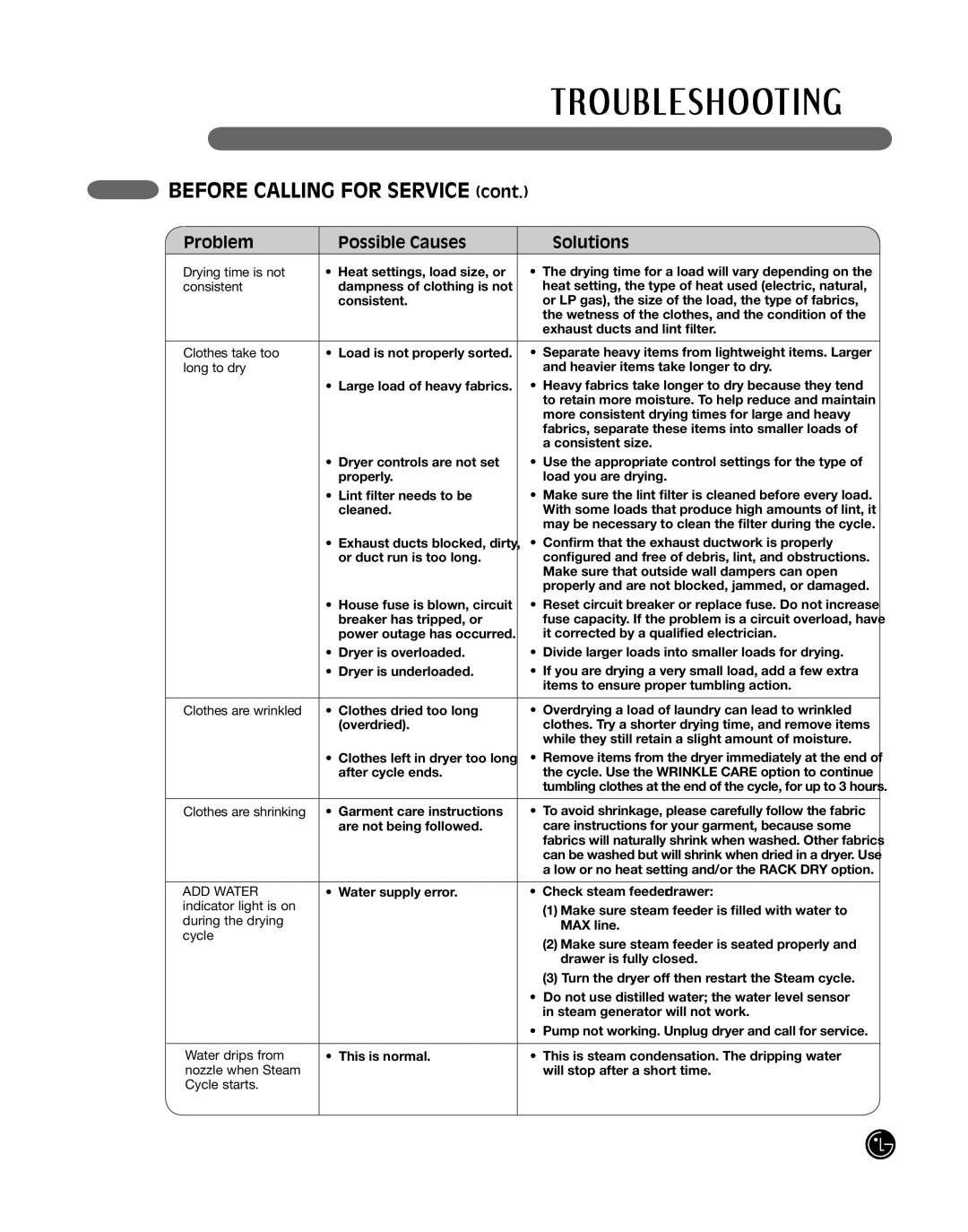
 BEFORE CALLING FOR SERVICE (cont.)
BEFORE CALLING FOR SERVICE (cont.)
Problem | Possible Causes |
| Solutions |
Drying time is not | • Heat settings, load size, or | • The drying time for a load will vary depending on the | |
consistent | dampness of clothing is not |
| heat setting, the type of heat used (electric, natural, |
| consistent. |
| or LP gas), the size of the load, the type of fabrics, |
|
|
| the wetness of the clothes, and the condition of the |
|
|
| exhaust ducts and lint filter. |
|
|
| |
Clothes take too | • Load is not properly sorted. | • Separate heavy items from lightweight items. Larger | |
long to dry |
|
| and heavier items take longer to dry. |
| • Large load of heavy fabrics. | • Heavy fabrics take longer to dry because they tend | |
|
|
| to retain more moisture. To help reduce and maintain |
|
|
| more consistent drying times for large and heavy |
|
|
| fabrics, separate these items into smaller loads of |
|
|
| a consistent size. |
| • Dryer controls are not set | • Use the appropriate control settings for the type of | |
| properly. |
| load you are drying. |
| • Lint filter needs to be | • | Make sure the lint filter is cleaned before every load. |
| cleaned. |
| With some loads that produce high amounts of lint, it |
|
|
| may be necessary to clean the filter during the cycle. |
| • Exhaust ducts blocked, dirty, | • Confirm that the exhaust ductwork is properly | |
| or duct run is too long. |
| configured and free of debris, lint, and obstructions. |
|
|
| Make sure that outside wall dampers can open |
|
|
| properly and are not blocked, jammed, or damaged. |
| • House fuse is blown, circuit | • Reset circuit breaker or replace fuse. Do not increase | |
| breaker has tripped, or |
| fuse capacity. If the problem is a circuit overload, have |
| power outage has occurred. |
| it corrected by a qualified electrician. |
| • Dryer is overloaded. | • Divide larger loads into smaller loads for drying. | |
| • Dryer is underloaded. | • If you are drying a very small load, add a few extra | |
|
|
| items to ensure proper tumbling action. |
|
|
| |
Clothes are wrinkled | • Clothes dried too long | • Overdrying a load of laundry can lead to wrinkled | |
| (overdried). |
| clothes. Try a shorter drying time, and remove items |
|
|
| while they still retain a slight amount of moisture. |
| • Clothes left in dryer too long | • Remove items from the dryer immediately at the end of | |
| after cycle ends. |
| the cycle. Use the WRINKLE CARE option to continue |
|
|
| tumbling clothes at the end of the cycle, for up to 3 hours. |
|
|
| |
Clothes are shrinking | • Garment care instructions | • To avoid shrinkage, please carefully follow the fabric | |
| are not being followed. |
| care instructions for your garment, because some |
|
|
| fabrics will naturally shrink when washed. Other fabrics |
|
|
| can be washed but will shrink when dried in a dryer. Use |
|
|
| a low or no heat setting and/or the RACK DRY option. |
|
|
| |
ADD WATER | • Water supply error. | • Check steam feeder drawer: | |
indicator light is on |
|
| (1) Make sure steam feeder is filled with water to |
during the drying |
|
| |
|
| MAX line. | |
cycle |
|
| |
|
| (2) Make sure steam feeder is seated properly and | |
|
|
| |
|
|
| drawer is fully closed. |
|
|
| (3) Turn the dryer off then restart the Steam cycle. |
|
| • | Do not use distilled water; the water level sensor |
|
|
| in steam generator will not work. |
|
| • | Pump not working. Unplug dryer and call for service. |
|
|
| |
Water drips from | • This is normal. | • This is steam condensation. The dripping water | |
nozzle when Steam |
|
| will stop after a short time. |
Cycle starts. |
|
|
|
|
|
|
|
37 ![]()
